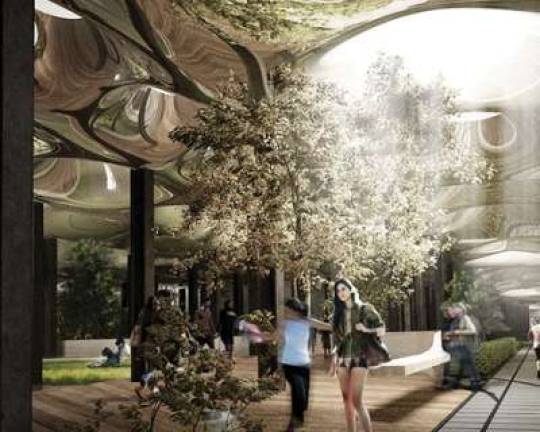The Delancey Underground

While the West Side has the High Line, the East Side could get the LowLine Over 80 years ago, Dan Barasch's grandparents on both sides ended up in the Lower East Side after emigrating from Italy and Russia. While his family eventually set up stakes in other neighborhoods and he settled in the East Village-which was at one point considered the Lower East Side-the area still holds special significance for Barasch. "My grandmother saw this neighborhood change to what it is today," he said. "It's an exciting neighborhood and it belongs to a lot of different people." It most likely would have seemed improbable to Barasch's ancestors that he and James Ramsey would set out on what promises to be a long journey to create New York City's first underground park, which the duo hopes to construct in an abandoned trolley terminal underneath Delancey Street. The idea has been in development since last year, and they have presented their proposal throughout the neighborhood, from the Tenement Museum on Orchard Street to the public school Essex Street Academy, and to city officials. For Barasch and Ramsey, the proposal, officially called Delancey Underground but nicknamed The LowLine after the famous High Line park on the West Side, is chiefly about serving the Lower East Side and surrounding community. Ramsey, a NASA engineer turned architect, is the founder and owner of Raad Studio on Chrystie Street, while Barasch previously promoted social innovations with companies and organizations like Google and the 9/11 Survivors' Fund. Both men pointed to a lack of green space in the neighborhood. "The more we looked into it, the more we saw how the Lower East Side has been historically underserved," said Ramsey. "It just happened that this space was here. It works in a number of ways and struck us as very strong from a community point of view." Ramsey went on to point out that community reaction to the proposal has been overwhelmingly positive and it has drawn praise from both the Lower East Side BID and City Council Member Margaret Chin. Growing support for the project is evidenced by their recent Kickstarter campaign. Although the Internet drive, which kicked off in late February, was to raise $100,000 by April 6, 2,517 backers have already pledged $134,040 (as of press time). As Barasch and Ramsey point out on their Kickstarter site, this initial round of funding will allow the pair to build a full-scale installation-a "mini LowLine"-at the Essex Street Market in September. The demo will not only help them to perfect the solar technology that will be used to naturally illuminate the park, but convince potential funders, the city and the MTA, which owns the property, that the idea is feasible. For the first phase of the project, Ramsey and Barasch hope to raise $500,000, which would be used not only the demonstration but also for a feasibility study. Barasch noted that they are often asked how much the project will cost, but without an initial study, it is difficult to arrive at a realistic number. "We haven't done constructability reviews, we haven't paid land use experts," Barasch explained, adding that a study would require coordination with roughly a dozen city agencies. While the MTA has yet to sign off on the project, representatives from the authority have met with Barasch and Ramsey and escorted them on their first tour of the site last March. Ramsey points out that the space is slightly visible from the Brooklyn-bound side of the J/Z platform at the Essex Street Subway station. "I am the kind of person, like a lot of New Yorkers, who loves to find secret spaces, abandoned lots and plots up for renewal?When we were underground, it was sort of like exploring a hidden gem," Barasch recalled. "The sheer scale of it-we aren't used to seeing that much unused real estate, and there were all of these architectural details, like cobblestones and crisscrossing rail lines. These exciting elements bring you back to a different era." According to Barasch and Ramsey, the space is around 60,000 square feet, nearly the size of Gramercy Park. It was constructed as a trolley terminal in 1903, the same year the Williamsburg Bridge was opened. At the time, streetcars were used to shuttle people back and forth from Williamsburg to the Lower East Side. Use of the trolleys and thus the terminal was discontinued in 1948. Ramsey and Barasch remain enamored of the unique historic aspects of the space, like the 20-foot vaulted ceilings and steel columns, but plan to incorporate cutting-edge technology that rivals science fiction. "The space is so compelling from a historical and aesthetic standpoint, I very much would love to preserve, juxtapose and compliment it using technology," Ramsey noted. As the pair explains on their Kickstarter page, the technology they hope to employ includes "a system of optics to gather sunlight, concentrate it and reflect it below ground, where it is dispersed by a solar distributor dish embedded in the ceiling. The light irrigated underground will carry the necessary wavelengths to support photosynthesis-meaning we can grow plants, trees and grasses underground." In addition to planning the demo and study, Barasch said they hope to continue meeting with members of the community to learn what they would like for the site. "We want to talk to as many residents as we can," he said. "We would like to build something beautiful that is inclusive of everyone." To learn more about the Delancey Underground project, visit delanceyunderground.org.